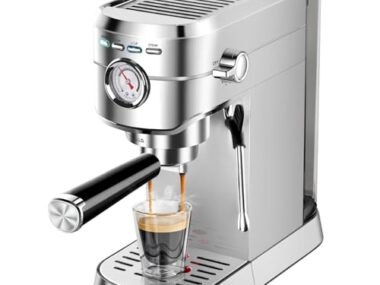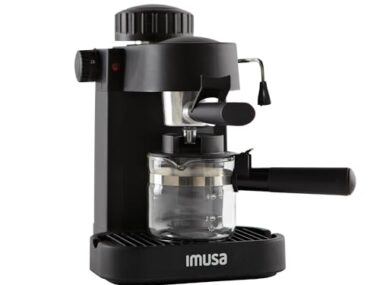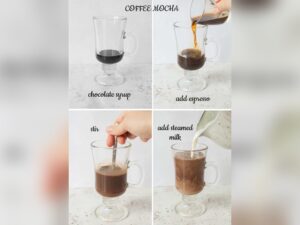Choosing the right espresso machine can be tricky. There are many options available.
The perfect espresso machine depends on your needs and preferences. Do you want a machine for home use or for a small café? Are you looking for something simple or more advanced? In this blog post, we’ll explore various espresso machines to help you decide which one to buy.
We’ll discuss key features to consider, such as ease of use, price, and maintenance. Understanding these aspects will make your decision easier. Whether you’re a coffee newbie or a seasoned barista, finding the right machine is crucial. Let’s dive into the world of espresso machines and find the best fit for you.
:max_bytes(150000):strip_icc()/sea-espresso-machines-test-breville-barista-touch-impress-nsimpson-185-2bcb7e344d13446bbc4bc13b3fbc6f02.jpeg)
Credit: www.seriouseats.com
Types Of Espresso Machines
Choosing the right espresso machine can be overwhelming. There are many types available, each with its own features and benefits. Understanding the different types can help you make an informed decision. Here are the main types of espresso machines:
Manual Machines
Manual espresso machines require you to do most of the work. You have full control over the brewing process. This can be both a blessing and a curse, depending on your skill level.
With a manual machine, you need to:
-
Grind the coffee beans
-
Fill the portafilter
-
Tamp the coffee
-
Control the water flow
-
Manage the brewing time
These machines are perfect for those who enjoy the art of making coffee. They allow for a personalized touch, letting you experiment with different techniques.
Benefits of manual machines:
-
Complete control over the brewing process
-
Ability to experiment with various methods
-
Often cheaper than automatic machines
Drawbacks:
-
Requires more skill and practice
-
Time-consuming
-
Can be difficult to master
Semi-automatic Machines
Semi-automatic machines offer a balance between control and convenience. They automate some parts of the brewing process while letting you manage others.
These machines typically have:
-
Electric pumps for water pressure
-
Automatic temperature controls
-
Manual controls for the brewing time and water flow
Benefits of semi-automatic machines:
-
More consistent results
-
Easier to use than manual machines
-
Allows for some personalization
Drawbacks:
-
Still requires some skill
-
Can be more expensive
Table summarizing features:
|
Feature |
Manual Machines |
Semi-Automatic Machines |
|---|---|---|
|
Control |
Complete |
Partial |
|
Ease of Use |
Difficult |
Moderate |
|
Cost |
Lower |
Higher |
Fully Automatic Machines
Fully automatic machines take convenience to the next level. They automate the entire brewing process, making it easy to get a consistent cup of espresso every time.
These machines often include:
-
Programmable settings
-
Automatic water flow control
-
Built-in grinders
Benefits of fully automatic machines:
-
Easy to use
-
Consistent results
-
Less skill required
Drawbacks:
-
More expensive
-
Less control over the brewing process
Super-automatic Machines
Super-automatic machines are the ultimate in convenience. They automate every step of the espresso-making process, from grinding the beans to frothing the milk.
These machines typically feature:
-
One-touch operation
-
Automatic milk frothing
-
Programmable coffee preferences
Benefits of super-automatic machines:
-
Perfect for busy individuals
-
Consistent and high-quality results
-
Minimal effort required
Drawbacks:
-
Highest cost
-
Limited control over customization
Table comparing automatic and super-automatic machines:
|
Feature |
Fully Automatic Machines |
Super-Automatic Machines |
|---|---|---|
|
Ease of Use |
High |
Very High |
|
Automation Level |
High |
Complete |
|
Cost |
Higher |
Highest |
Budget Considerations
Buying an espresso machine can be exciting, but figuring out the right one for your needs can be daunting. Budget is a crucial consideration when choosing the perfect espresso machine. Whether you are a beginner, an intermediate user, or a coffee aficionado, there are options available that suit different budgets. Let’s dive into the budget considerations for different types of espresso machines.
Entry-level Options
For those just starting their espresso journey, entry-level options are a great place to start. These machines are affordable and easy to use. They provide a good balance between cost and functionality. Here are some features to look out for:
-
Price Range: $100 – $300
-
Ease of Use: User-friendly with simple controls
-
Portability: Generally compact and lightweight
-
Maintenance: Easy to clean and maintain
Popular entry-level machines include:
|
Brand |
Model |
Price |
|---|---|---|
|
De’Longhi |
EC155 |
$99 |
|
Mr. Coffee |
Automatic Dual Shot |
$139 |
|
Breville |
ESP8XL Cafe Roma |
$249 |
Entry-level machines are perfect for those who want to enjoy espresso without a significant investment.
Mid-range Choices
Mid-range espresso machines offer better performance and more features than entry-level options. They are suitable for those who have some experience and want to take their espresso-making skills to the next level. Key features include:
-
Price Range: $300 – $700
-
Build Quality: More durable materials, often stainless steel
-
Features: Programmable settings, better temperature control
-
Milk Frothing: Steam wands for frothing milk
Popular mid-range models include:
|
Brand |
Model |
Price |
|---|---|---|
|
Gaggia |
Classic Pro |
$399 |
|
Breville |
Barista Express |
$599 |
|
Rancilio |
Silvia |
$730 |
Mid-range machines are ideal for enthusiasts who want a balance between price, features, and quality.
High-end Machines
High-end espresso machines are for serious coffee lovers who want the best possible espresso experience. These machines offer advanced features and exceptional build quality. Here are some key characteristics:
-
Price Range: $1000 and above
-
Performance: Professional-level with precise temperature control
-
Materials: High-quality materials like stainless steel and brass
-
Customization: Extensive options for customizing espresso
Popular high-end models include:
|
Brand |
Model |
Price |
|---|---|---|
|
La Marzocco |
Linea Mini |
$4,500 |
|
Rocket Espresso |
R58 |
$3,000 |
|
ECM |
Synchronika |
$3,200 |
High-end machines are perfect for those who want to replicate a cafe-quality experience at home.
Key Features To Look For
Choosing the right espresso machine can be overwhelming. Key features make a huge difference in the quality of your coffee. This guide helps you understand what to look for.
Pressure And Temperature Control
Pressure and temperature control are crucial for a perfect espresso. The pressure ensures water passes through the coffee grounds at the right speed. The ideal pressure is around 9 bars. Look for machines that offer consistent pressure.
Temperature control is equally important. The water should be between 195°F and 205°F for optimal extraction. Machines with adjustable temperature settings give you more control.
-
Consistent pressure: Look for machines with a stable pressure gauge.
-
Adjustable temperature: Machines that let you set the temperature precisely.
-
PID controller: Helps maintain stable temperature.
A machine with good pressure and temperature control ensures you get the best flavor from your coffee. Consistency is key. A stable machine will produce better espresso shots.
Built-in Grinder
A built-in grinder simplifies the process. Freshly ground coffee enhances flavor. Look for machines with a high-quality grinder. Burr grinders are preferred over blade grinders.
Consider these points:
-
Grind size settings: Adjustable settings for different coffee types.
-
Grind consistency: Ensures even extraction.
-
Ease of cleaning: Removable parts for easy cleaning.
A built-in grinder saves time and space. It ensures your coffee is freshly ground each time. Consistency in grind size affects the taste. Look for a machine with a reliable grinder.
Frothing Capability
Frothing capability is essential for making milk-based drinks like lattes and cappuccinos. Look for machines with a steam wand or automatic frother. These features create creamy, frothy milk.
Important aspects:
-
Steam wand: Manual control for perfect froth.
-
Automatic frother: Convenient and easy to use.
-
Ease of use: Intuitive controls and settings.
A machine with good frothing capability expands your drink options. A powerful steam wand helps create barista-quality drinks. Whether you prefer manual or automatic frothing, ensure it meets your needs.
Top Brands And Models
Choosing the right espresso machine can be a daunting task. With so many brands and models available, it’s essential to know which ones stand out. In this section, we’ll explore some of the top brands and models in the market to help you make an informed decision. These brands are known for their quality, durability, and performance.
Breville
Breville is a well-known brand that produces high-quality espresso machines. They are popular for their user-friendly designs and advanced features. Here are some of the top models from Breville:
-
Breville Barista Express: This model is perfect for beginners and offers a built-in grinder, making it easy to use.
-
Breville Bambino Plus: Known for its quick heat-up time and compact design, it is ideal for small kitchens.
-
Breville Dual Boiler: A great choice for those who want professional-level performance at home, featuring precise temperature control and dual boilers.
Here is a quick comparison of these models:
|
Model |
Features |
Price Range |
|---|---|---|
|
Barista Express |
Built-in grinder, Steam wand, Easy to clean |
$600 – $700 |
|
Bambino Plus |
Fast heat-up, Compact size, Automatic steam wand |
$400 – $500 |
|
Dual Boiler |
Dual boilers, Precise temperature control, PID control |
$1,200 – $1,400 |
De’longhi
De’Longhi is another popular brand known for its reliable and stylish espresso machines. They offer a range of models suitable for different budgets and preferences. Some of their top models include:
-
De’Longhi Magnifica: An affordable super-automatic machine that offers a variety of features, including a built-in grinder and milk frother.
-
De’Longhi Dedica: A sleek and compact machine, perfect for small spaces and easy to use.
-
De’Longhi La Specialista: Combines manual and automatic features, providing a professional feel with ease of use.
Below is a comparison of these models:
|
Model |
Features |
Price Range |
|---|---|---|
|
Magnifica |
Super-automatic, Built-in grinder, Milk frother |
$700 – $800 |
|
Dedica |
Compact design, Fast heat-up, Easy to use |
$300 – $400 |
|
La Specialista |
Hybrid manual/automatic, Sensor grinding, Smart tamping station |
$800 – $900 |
Rancilio
Rancilio is a brand that stands out for its professional-grade machines. They are known for their durability and high performance. Some of the top models from Rancilio are:
-
Rancilio Silvia: A popular choice for home baristas, offering excellent build quality and consistent performance.
-
Rancilio Silvia Pro: An upgraded version of the Silvia, featuring dual boilers and digital temperature control.
Here is a comparison of these models:
|
Model |
Features |
Price Range |
|---|---|---|
|
Silvia |
Single boiler, Manual controls, Durable build |
$700 – $800 |
|
Silvia Pro |
Dual boilers, PID control, Advanced features |
$1,600 – $1,700 |
Gaggia
Gaggia is a brand with a long history in the espresso machine market. They offer a range of models that cater to both beginners and experienced users. Some of their top models include:
-
Gaggia Classic Pro: A reliable and affordable machine, perfect for beginners who want to start making espresso at home.
-
Gaggia Brera: A compact super-automatic machine, offering ease of use and a built-in grinder.
-
Gaggia Anima Prestige: A versatile machine with programmable options and a milk carafe for automatic frothing.
Comparison of these models:
|
Model |
Features |
Price Range |
|---|---|---|
|
Classic Pro |
Manual controls, Stainless steel body, Steam wand |
$400 – $500 |
|
Brera |
Super-automatic, Built-in grinder, Compact size |
$500 – $600 |
|
Anima Prestige |
Programmable options, Milk carafe, User-friendly interface |
$800 – $900 |
Size And Space Requirements
Choosing the right espresso machine involves many factors. One crucial aspect is the size and space requirements. This is important, especially if you have limited kitchen space or need a portable option. Let’s explore the different considerations for counter space, storage, and portability.
Counter Space
Before buying an espresso machine, consider your available counter space. Espresso machines come in various sizes, from compact models to larger, more professional ones. Here are some points to think about:
-
Compact Models: Ideal for small kitchens or limited counter space. They usually measure around 12 x 12 inches.
-
Mid-Size Models: These are a good balance between features and size. They often measure around 16 x 14 inches.
-
Large Models: Best suited for spacious kitchens. They can be as large as 20 x 20 inches.
Check the dimensions of the machine and compare it with your counter space. Ensure there is enough room to operate the machine comfortably. You might also want some extra space for accessories like coffee grinders or milk frothers.
|
Model Size |
Dimensions |
Best For |
|---|---|---|
|
Compact |
12 x 12 inches |
Small kitchens |
|
Mid-Size |
16 x 14 inches |
Medium kitchens |
|
Large |
20 x 20 inches |
Large kitchens |
Storage Considerations
Think about where you will store your espresso machine when not in use. Storage space is crucial if you have a small kitchen or if you like to keep your counters clear. Here are some tips:
-
Cabinet Space: Ensure your cabinets can accommodate the height and depth of the machine. Measure the space beforehand.
-
Weight: Heavier machines can be difficult to move. Check if you can lift and store it easily.
-
Accessories: Consider where you will store additional items like coffee pods, grinders, and milk frothers. A designated drawer or shelf can help keep everything organized.
Make sure to measure the storage space and compare it with the machine’s dimensions. This helps in deciding if the machine fits well without causing clutter.
Portability
If you need to move your espresso machine often, portability is key. Lightweight and compact machines are easier to transport. Here are some points to consider:
-
Weight: Lighter machines are easier to carry. Look for models weighing around 10-15 pounds.
-
Size: Smaller machines are easier to fit into different spaces. Compact models are great for portability.
-
Design: Some machines come with built-in handles or carrying cases. These features make transportation more convenient.
Portability is especially important if you plan to take your espresso machine to the office, on trips, or to events. Ensure the machine is easy to pack and set up wherever you go.

Credit: www.youtube.com
Maintenance And Cleaning
When choosing an espresso machine, understanding maintenance and cleaning is crucial. Proper care ensures longevity and optimal performance. Let’s explore the essential steps for keeping your machine in top shape.
Daily Maintenance
Daily maintenance keeps your espresso machine running smoothly and ensures your coffee tastes fresh. Here are some essential tasks to perform every day:
-
Wipe the Steam Wand: After each use, wipe the steam wand with a damp cloth to remove milk residue. Purge the wand by steaming for a few seconds.
-
Clean the Portafilter: Remove the portafilter, knock out the used coffee grounds, and rinse it under warm water. Ensure there are no coffee residues.
-
Empty the Drip Tray: Check and empty the drip tray regularly to avoid overflow. Rinse it with warm water and mild soap.
-
Rinse the Water Tank: Refill the water tank with fresh water daily. Rinse it to remove any sediment or impurities.
-
Wipe the Exterior: Use a damp cloth to wipe the machine’s exterior, removing any coffee splashes or stains.
Deep Cleaning
Deep cleaning should be done weekly to remove buildup and ensure your machine’s longevity. Follow these steps for a thorough clean:
-
Backflush the Machine: If your machine has a backflush feature, use a blind filter and cleaning tablets. Run the backflush cycle as per the manufacturer’s instructions.
-
Clean the Group Head: Remove the group head screen and soak it in warm water with a cleaning solution. Use a brush to scrub away coffee oils and residues.
-
Soak the Portafilter and Baskets: Place the portafilter and baskets in a container with a cleaning solution. Soak them for 20-30 minutes, then rinse thoroughly.
-
Clean the Steam Wand Thoroughly: Remove the steam wand tip and soak it in a cleaning solution. Use a brush to clean the inside of the wand.
-
Wipe Down All Parts: Wipe all machine parts with a damp cloth and mild soap. Ensure no cleaning solution residues are left.
Descaling Process
Descaling is essential for removing mineral buildup from your espresso machine. Perform descaling every 2-3 months or as recommended by the manufacturer. Here’s how to descale your machine:
|
Step |
Description |
|---|---|
|
1 |
Prepare the Solution: Mix a descaling solution with water as per the instructions. You can use a commercial descaler or a homemade solution of equal parts water and white vinegar. |
|
2 |
Fill the Water Tank: Pour the descaling solution into the water tank of your machine. |
|
3 |
Run the Machine: Turn on the machine and run it as if you are making coffee. Allow the solution to pass through the system. |
|
4 |
Rinse Thoroughly: After descaling, rinse the water tank and fill it with fresh water. Run the machine several times to flush out any remaining descaling solution. |
|
5 |
Clean the Portafilter and Group Head: Ensure no descaling solution remains in the portafilter and group head. Rinse them thoroughly with water. |
User Reviews And Ratings
Choosing the right espresso machine can be a daunting task. User reviews and ratings play a crucial role in making this decision easier. By understanding what other customers and experts say, you can find the perfect machine for your needs.
Customer Feedback
Customer feedback is invaluable when choosing an espresso machine. Real users share their experiences, both good and bad. This helps you understand what to expect from each model.
Common points in customer reviews:
-
Ease of use: Many users value machines that are easy to operate.
-
Durability: Customers often mention how long their machine lasts.
-
Taste: The quality of the espresso is a key point in reviews.
-
Price: Users discuss if the machine is worth its price.
Here is a table summarizing common customer feedback:
|
Model |
Ease of Use |
Durability |
Taste |
Price |
|---|---|---|---|---|
|
Model A |
4/5 |
3/5 |
5/5 |
$$$ |
|
Model B |
5/5 |
4/5 |
4/5 |
$$ |
|
Model C |
3/5 |
5/5 |
3/5 |
$$$ |
Expert Reviews
Experts offer insights based on technical knowledge and extensive testing. Their reviews often cover:
-
Build quality: Experts assess the materials and construction.
-
Performance: They test the machine’s efficiency and consistency.
-
Features: Experts detail the unique features of each model.
-
Value: They evaluate if the machine offers good value for money.
Here is a summary of expert opinions on popular models:
|
Model |
Build Quality |
Performance |
Features |
Value |
|---|---|---|---|---|
|
Model A |
Excellent |
High |
Advanced |
Good |
|
Model B |
Good |
Moderate |
Basic |
Very Good |
|
Model C |
Average |
High |
Moderate |
Fair |
Comparison Charts
Comparison charts are helpful tools. They allow you to quickly see the differences between models. Below is a comparison chart for popular espresso machines:
|
Model |
Price |
Ease of Use |
Durability |
Features |
Taste |
|---|---|---|---|---|---|
|
Model A |
$$$ |
4/5 |
3/5 |
Advanced |
5/5 |
|
Model B |
$$ |
5/5 |
4/5 |
Basic |
4/5 |
|
Model C |
$$$ |
3/5 |
5/5 |
Moderate |
3/5 |
By using customer feedback, expert reviews, and comparison charts, you can make an informed decision. Find the espresso machine that suits your needs and budget.
Where To Buy
Choosing the right espresso machine can be a daunting task. Once you have decided on the type and features you want, the next step is finding the best place to make your purchase. There are several options available, each with its own set of advantages. Knowing where to buy can save you time and money while ensuring you get the best product for your needs.
Online Retailers
Online retailers offer convenience and a wide range of options. You can compare different brands and models without leaving your home. Here are some popular online platforms to consider:
-
Amazon: Amazon provides a vast selection of espresso machines from various brands. They offer customer reviews, which can be very helpful in making a decision. Prime members also enjoy fast shipping.
-
Best Buy: Best Buy’s website has detailed product descriptions and customer ratings. They often have sales and price matches.
-
Specialty Coffee Websites: Websites like Seattle Coffee Gear and Whole Latte Love focus on coffee equipment. They provide expert advice and detailed reviews.
Shopping online allows you to read reviews from other customers. This can give you a better idea of a machine’s performance and reliability. Most online retailers also offer easy return policies, which adds a layer of security to your purchase.
Local Shops
Buying from local shops has its own set of benefits. You can see and touch the product before you buy it. Here are some types of local shops you can visit:
-
Electronics Stores: Stores like Best Buy have a section dedicated to kitchen appliances, including espresso machines. They often have knowledgeable staff who can guide you.
-
Department Stores: Major department stores like Macy’s and Target carry a variety of espresso machines. They frequently have sales and promotions.
-
Specialty Coffee Shops: Some coffee shops sell high-end espresso machines. They can offer expert advice and may even provide demonstrations.
Local shops allow you to see the machine in action. You can get a feel for the build quality and ease of use. Talking to salespeople can also give you insights that you might not get online.
Second-hand Options
Buying a second-hand espresso machine can be a great way to save money. Here are some places to look for used machines:
-
Online Marketplaces: Websites like eBay and Craigslist have listings for used espresso machines. Look for sellers with good ratings and detailed descriptions.
-
Local Classifieds: Check your local newspaper or community bulletin boards for listings.
-
Thrift Stores: Stores like Goodwill sometimes have used espresso machines at very low prices.
When buying second-hand, make sure to inspect the machine carefully. Ask the seller about its history and any issues it might have. Sometimes, you can find high-quality machines that have barely been used.

Credit: www.reddit.com
Frequently Asked Questions
Which Espresso Machine Should I Buy For Home?
Consider the Breville Barista Express for home use. It offers great value, built-in grinder, and excellent espresso quality.
What’s Better, A 15 Bar Or 20 Bar Espresso Machine?
A 15 bar espresso machine is generally sufficient for home use. It provides ample pressure for a good espresso. A 20 bar machine is typically more suited for commercial use but can offer more consistency. Choose based on your needs.
Which Espresso Machine Is Used By Starbucks?
Starbucks uses the Mastrena espresso machine. This Swiss-made machine is known for its efficiency and consistency in brewing.
What Features To Look For In An Espresso Machine?
Look for features like a built-in grinder, milk frother, and programmable settings. These enhance your coffee experience. Also, consider the machine’s size, ease of cleaning, and durability.
Conclusion
Choosing the right espresso machine depends on your needs and budget. Consider features like ease of use, durability, and size. Compare different brands and read reviews for better insights. Remember, a good espresso machine can enhance your coffee experience. Take your time and make an informed decision.
Enjoy brewing your perfect cup of espresso at home. Happy coffee making!







